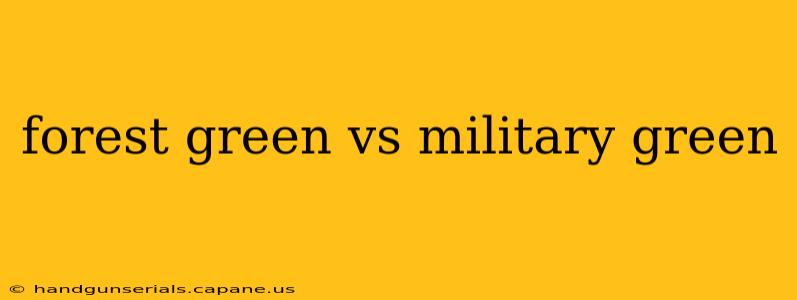Choosing the right shade of green can be surprisingly tricky, especially when navigating the subtle differences between seemingly similar colors like forest green and military green. While both evoke a sense of nature and ruggedness, they possess distinct characteristics that set them apart. This detailed comparison will delve into the nuances of each shade, helping you confidently select the perfect green for your next project, whether it's painting a room, choosing clothing, or designing a logo.
Understanding the Color Palette: Forest Green
Forest green conjures images of lush forests, deep woodlands, and the vibrancy of untouched nature. It's a rich, dark green often described as having a yellowish or brownish undertone, lending it a sense of depth and warmth. Think of the deep green of moss clinging to ancient trees or the rich foliage of a secluded woodland.
Key Characteristics of Forest Green:
- Hue: A deep, saturated green.
- Undertones: Typically yellowish or brownish, adding warmth.
- Saturation: High, resulting in a rich and intense color.
- Brightness: Relatively low, creating a sophisticated and calming effect.
- Applications: Ideal for creating a sense of tranquility and natural beauty in interior design, fashion (think sophisticated outerwear or accessories), and branding where a sophisticated, earthy feel is desired.
Deciphering the Shade: Military Green
Military green, also sometimes referred to as olive green, boasts a more muted and subdued appearance compared to forest green. Its historical association with military uniforms influences its perception; it's often associated with strength, resilience, and practicality. The color itself is typically a darker, more muted green, often leaning towards gray or brown.
Key Characteristics of Military Green:
- Hue: A darker, more subdued green.
- Undertones: Often gray or brown, giving it a muted and earthy quality.
- Saturation: Lower than forest green, creating a less intense and more camouflage-like appearance.
- Brightness: Low, contributing to its understated and utilitarian feel.
- Applications: Commonly used in military apparel, outdoor gear, and in design contexts where a rugged, understated, and practical aesthetic is desired. It's also a popular choice for utilitarian-style home décor.
The Head-to-Head Comparison: Forest Green vs. Military Green
| Feature | Forest Green | Military Green |
|---|---|---|
| Hue | Deep, vibrant green | Darker, more muted green |
| Undertones | Yellowish or brownish | Grayish or brownish |
| Saturation | High | Low |
| Brightness | Relatively low | Low |
| Overall Feel | Rich, warm, natural, sophisticated | Muted, earthy, rugged, practical |
| Best Uses | Interior design, fashion (sophisticated), branding | Military apparel, outdoor gear, utilitarian design |
Conclusion: Choosing the Right Green
The choice between forest green and military green ultimately depends on the desired aesthetic and application. Forest green offers a rich, vibrant, and sophisticated feel, while military green provides a more muted, practical, and rugged look. Understanding the subtle differences in their undertones, saturation, and brightness will guide you towards making the perfect choice for your specific needs. Consider the overall ambiance you want to create and the message you wish to convey when making your decision.

